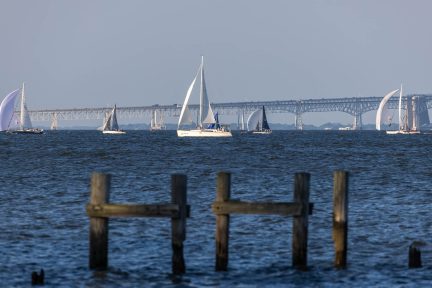Seventeen public access sites open along Chesapeake rivers and streams
Seventeen public access sites open along Chesapeake rivers and streams
Last year, Chesapeake Bay Program partners opened 17 boat ramps, fishing piers and other sites that allow the public to access rivers, streams and the Chesapeake Bay. Virginia opened 14 sites, while Maryland, Pennsylvania, and New York each opened one. There are now 1,225 public places that allow people across the watershed to walk, play, swim, fish and launch their paddleboats, sailboats and powerboats into the water.
Through the Chesapeake Bay Watershed Agreement, our partners have committed to bringing the number of public access sites in the region to 1,439 by 2025. We track public access as an indicator of our progress toward fostering environmental stewardship. Since tracking began in 2010, partners have opened 86 new sites, meeting 29 percent of our goal.
Partnerships between local, state and federal agencies and non-profit organizations have been essential in developing these sites: a soft launch for paddlecraft opened on the Chickahominy River with support from the James River Association. Walking trails, wildlife viewing platforms and interpretive signs were built on U.S. Fish and Wildlife Service land along Mount Landing Creek with support from the Virginia State Park Youth Conservation Corps. And a boat dock, wildlife viewing platform and public pavilion, as well as fishing access, were established at the Zimmerman Center for Heritage on the Susquehanna River with support from Pennsylvania’s Fish and Boat Commission, Department of Conservation and Natural Resources, and Department of Transportation, as well as the National Park Service and local donors.
While the number of access sites opened in 2014 is lower than the 36 sites opened in 2013, experts do not expect this decline to continue. Significant grant funding from federal and state agencies was distributed toward public access in 2013; a number of the sites that were funded at this time are still under development and should open in the coming years.
Facts
In 2014, 17 new access sites were opened to the public. Virginia opened 14 sites, while Maryland, Pennsylvania, and New York each opened one. This brings the total number of access sites in the Chesapeake Bay watershed to 1,225.
| Site | Water Body | County | Description |
|---|---|---|---|
| Shady Side Park | West River | Anne Arundel | Soft launch for non-motorized vessels and river access from a natural shoreline. |
| Site | Water Body | County | Description |
|---|---|---|---|
| Parslow Road Conservation Area | Oaks Creek | Otsego | Paddlecraft launch, fishing access and walking trail. |
| Site | Water Body | County | Description |
|---|---|---|---|
| Zimmerman Center for Heritage | Susquehanna River | York | Boat dock and fishing access, wildlife viewing platform, public pavilion and interpretive signa |
| Site | Water Body | County | Description |
|---|---|---|---|
| Grapevine Bridge | Chickahominy | Henrico | Soft launch for non-motorized vessels. |
| Grey's Creek Boat Ramp | Grey's Creek | Surry | Soft launch for non-motorized vessels and rebuilt pier. |
| Clifton Forge | Jackson River | Alleghany | Soft launch for non-motorized vessels, fishing access and walking trail. |
| Covington | Jackson River | Alleghany | Soft launch for non-motorized vessels, fishing access and walking trail. |
| Glasgow | James River | Rockbridge | Soft launch for non-motorized vessels, fishing access and walking trail. |
| Wellford Tract | Little Carter Creek | Richmond | Walking trail. |
| Williams Wharf Landing | East River (Mobjack Bay) | Mathews | Boat access. |
| Morris Creek | Morris Creek | Charles City | Soft launch for non-motorized vessels and fishing access. |
| Hutchinson Tract | Mount Landing Creek | Essex | Boat access, walking trail and interpretive signage. |
| Hutchinson Tract Viewing Platforms | Mount Landing Creek | Essex | Wildlife viewing platforms and walking trail. |
| Pitts Creek Landing | Pocomoke River | Accomack | Boat ramp, soft launch for non-motorized vessels and fishing access. |
| City Dock | Rappahannock River | City of Fredericksburg | Renovated boat landing, shoreline and platform fishing access, and walking trail. |
| Port Royal | Rappahannock River | Caroline | Soft launch for non-motorized vessels. |
| Simpson's Landing | Shenandoah River | Warren | Non-powerboat and fishing access. |
Issues
As development continues across the Chesapeake Bay watershed, demand for places that allow the public to reach the water remains high. State, federal and local governments are often the guardians of these places, providing opportunities for everyone to enjoy the region’s natural and cultural bounty. Because physical access to the Bay and its tributaries remains limited—with real consequences for quality of life, the economy and long-term conservation—Chesapeake Bay Program partners set a goal to bring the total number of access sites in the watershed to 1,439 by 2025.
Importance
Public access to open space and waterways can improve public health and quality of life. People rely on outdoor places to exercise, relax and revive their spirits. Time outdoors can strengthen family bonds and nurture fit, creative children. And access to the Chesapeake Bay and its tributaries can build personal connections with the places that have shaped life in the region for centuries. This has a distinct economic and environmental value, as it boosts tourism and creates citizen stewards who care for local resources and engage in the conservation of the Bay and its many resources.
Quotes
“Connecting people to the Chesapeake by providing access is one of the best investments we can make to ensure current and future generations love and care for the Chesapeake.”
--- Chuck Hunt, Superintendent, National Park Service Chesapeake Bay Office
“As an avid kayaker, I know the importance of having access to rivers, creeks and streams throughout the Chesapeake Bay watershed. As we come to know the resource through access to it, we will understand its value. Once we know its value, we will be more inclined to take actions to protect it. Public access is critical to restoring this vital ecosystem.”
--- Nick DiPasquale, Director, Chesapeake Bay Program



